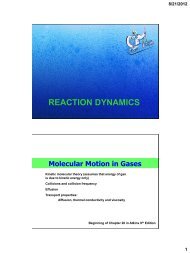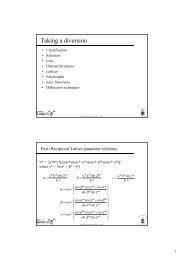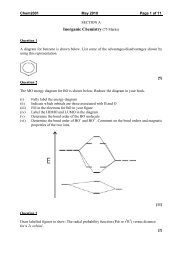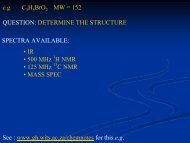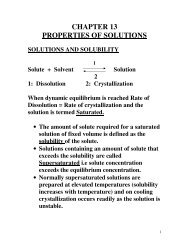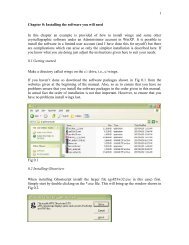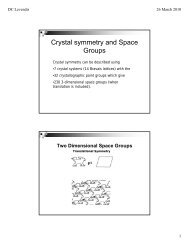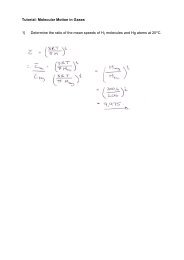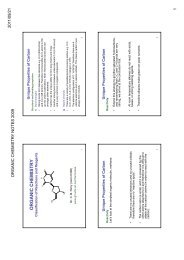ELECTROCHEMISTRY - Wits Structural Chemistry
ELECTROCHEMISTRY - Wits Structural Chemistry
ELECTROCHEMISTRY - Wits Structural Chemistry
You also want an ePaper? Increase the reach of your titles
YUMPU automatically turns print PDFs into web optimized ePapers that Google loves.
w max = ∆G<br />
Before Equilibrium<br />
The Cell Potential<br />
Consider a galvanic cell reaction:<br />
The cell can do electrical work by driving<br />
e − ’s through the external circuit.<br />
The larger the potential difference between the<br />
two electrodes, the more work can be done by<br />
each e−.<br />
Measure E cell by applying an opposing<br />
potential s.t. the reaction occurs reversibly<br />
and the composition is constant (no nett<br />
current flows).<br />
∆G = −nFE cell<br />
for electrical work for a<br />
reversible reaction<br />
At Equilibrium<br />
No more work can be done<br />
E cell = 0 V<br />
The composition in electrode compartment is expressed by:<br />
the reaction quotient, Q<br />
the equilibrium constant, K<br />
Derive Nernst equation:<br />
RT<br />
E = E<br />
o − ln Q<br />
nF<br />
Applies to:<br />
∆G = −nFE<br />
Half-reactions<br />
RT<br />
E<br />
nF<br />
and<br />
Cells<br />
RT<br />
nF<br />
o<br />
o<br />
= Ered<br />
− lnQred<br />
E = Ecell<br />
− lnQrxn<br />
Half-cell reaction written as a<br />
reduction reaction.<br />
Nernst Equation<br />
o<br />
∆G<br />
= ∆G<br />
+ RT ln Q<br />
2.303 RT<br />
E = E<br />
o − log Q<br />
nF<br />
E<br />
o<br />
cell<br />
= E<br />
o<br />
cathode<br />
− E<br />
o<br />
anode<br />
NOTE: E o used in the calculations are always for the reduction reactions.<br />
loge<br />
x<br />
log x =<br />
10<br />
loge<br />
10<br />
2 .303 log x = ln x<br />
0.05916<br />
E = E<br />
o − log Q at 25°C<br />
n<br />
E o = standard cell potential all reactants and products in their standard states,<br />
thus all activities = 1<br />
∆G = −nFE<br />
Do Self-test 6.7<br />
Standard Reduction Potentials in H 2 O at 25 o C<br />
The cell reaction is spontaneous<br />
if E cell > 0<br />
At equilibrium:<br />
∆G = 0 E cell = 0 and Q = K<br />
Strong oxidising<br />
agent<br />
Gibbs free energy, G<br />
∆G < 0<br />
E > 0<br />
∆G = 0<br />
E = 0<br />
∆G > 0<br />
E < 0<br />
RT<br />
E = E<br />
− lnQ<br />
nF<br />
RT<br />
0 E − lnK<br />
nF<br />
= nF <br />
ln K = E<br />
RT<br />
E > 0 <br />
spontaneous<br />
reduction<br />
reactants<br />
Extent of reaction<br />
products<br />
The steeper the slope, the greater<br />
the driving power of the cell.<br />
Recall:<br />
∆G°= –RT ln K<br />
∆G°= –nFE°<br />
E < 0 nonspontaneous<br />
reduction<br />
Strong reducing<br />
agent<br />
Example 1<br />
Consider the Daniell cell:<br />
Using the standard reduction potentials, calculate the equilibrium constant at 25 °C.<br />
Standard reduction potentials at 25 °C:<br />
Cu 2+ + 2e - → Cu(s)<br />
Zn 2+ + 2e - → Zn(s)<br />
Zn(s)<br />
ZnSO 4 (aq) CuSO 4 (aq) Cu(s)<br />
E o = +0.34 V<br />
E o = −0.76 V<br />
Do Self-test 6.8<br />
Metal/metal ion:<br />
e.g. Zn(s) in zinc ion solution<br />
M(s) | M n+ (aq)<br />
Metal-insoluble salt: M(s) | MX(s) | X - (aq)<br />
e.g. silver-silver chloride electrode<br />
−<br />
Ag(s)<br />
AgCl(s) Cl (aCl)<br />
AgCl(s) + e - Ag(s) + Cl - (aq)<br />
Inert electrode: Pt(s) | M n+ (aq), M p+ (aq)<br />
e.g. Pt immersed in a solution containing a redox couple<br />
4 + 3+<br />
Pt(s) Ce (aq),Ce (aq)<br />
Ce 4+ + e - Ce 3+<br />
o RT a<br />
E = E − ln<br />
F a<br />
Gas electrode:<br />
Zn 2+ + 2e - Zn(s)<br />
Pt(s) | X 2 (g) | X +/− (aq)<br />
e.g. a standard hydrogen electrode<br />
+<br />
Pt(s)<br />
H2(g)<br />
H (aq)<br />
2H + + 2e - H 2 (g)<br />
Types of Electrodes<br />
E<br />
E<br />
RT<br />
2F<br />
o<br />
= E − ln<br />
2+<br />
RT<br />
F<br />
o<br />
= E − ln a<br />
−<br />
Cl<br />
RT<br />
2F<br />
1<br />
a<br />
p<br />
3+<br />
Ce<br />
4+<br />
Ce<br />
o<br />
H2<br />
E = E − ln<br />
2<br />
a<br />
Zn<br />
+<br />
H<br />
2



